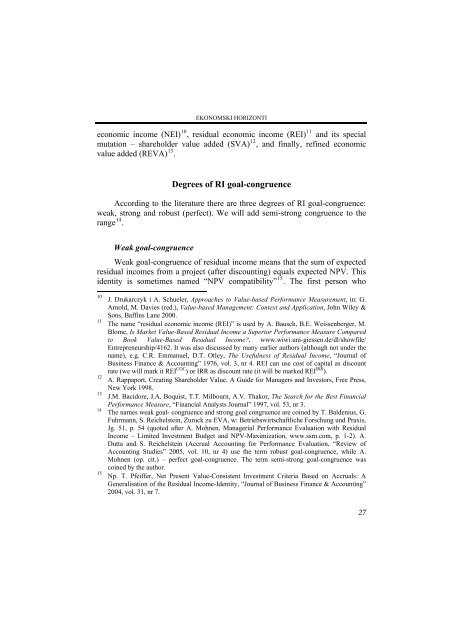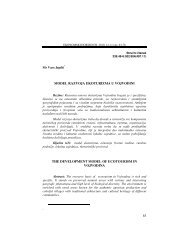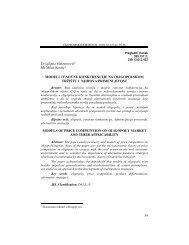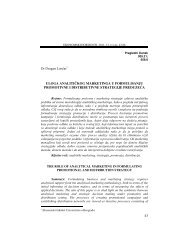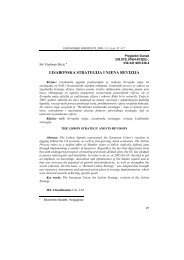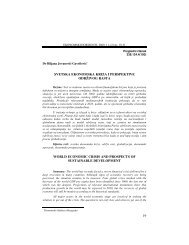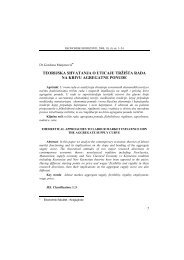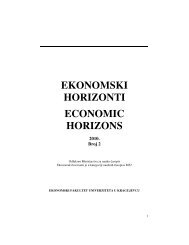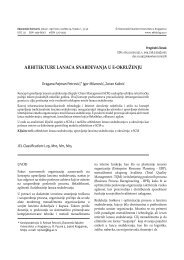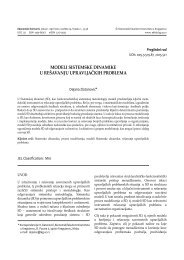EKONOMSKI HORIZONTI ECONOMIC HORIZONS 2008. Broj 1-2
EKONOMSKI HORIZONTI ECONOMIC HORIZONS 2008. Broj 1-2
EKONOMSKI HORIZONTI ECONOMIC HORIZONS 2008. Broj 1-2
You also want an ePaper? Increase the reach of your titles
YUMPU automatically turns print PDFs into web optimized ePapers that Google loves.
<strong>EKONOMSKI</strong> <strong>HORIZONTI</strong><br />
economic income (NEI) 10 , residual economic income (REI) 11 and its special<br />
mutation – shareholder value added (SVA) 12 , and finally, refined economic<br />
value added (REVA) 13 .<br />
Degrees of RI goal-congruence<br />
According to the literature there are three degrees of RI goal-congruence:<br />
weak, strong and robust (perfect). We will add semi-strong congruence to the<br />
range 14 .<br />
Weak goal-congruence<br />
Weak goal-congruence of residual income means that the sum of expected<br />
residual incomes from a project (after discounting) equals expected NPV. This<br />
identity is sometimes named “NPV compatibility” 15 . The first person who<br />
10<br />
11<br />
12<br />
13<br />
14<br />
15<br />
J. Drukarczyk i A. Schueler, Approaches to Value-based Performance Measurement, in: G.<br />
Arnold, M. Davies (red.), Value-based Management: Context and Application, John Wiley &<br />
Sons, Baffins Lane 2000.<br />
The name “residual economic income (REI)” is used by A. Bausch, B.E. Weissenberger, M.<br />
Blome, Is Market Value-Based Residual Income a Superior Performance Measure Compared<br />
to Book Value-Based Residual Income?, www.wiwi.uni-giessen.de/dl/showfile/<br />
Entrepreneurship/4162. It was also discussed by many earlier authors (although not under the<br />
name), e.g. C.R. Emmanuel, D.T. Otley, The Usefulness of Residual Income, “Journal of<br />
Business Finance & Accounting” 1976, vol. 3, nr 4. REI can use cost of capital as discount<br />
rate (we will mark it REI COC ) or IRR as discount rate (it will be marked REI IRR ).<br />
A. Rappaport, Creating Shareholder Value. A Guide for Managers and Investors, Free Press,<br />
New York 1998.<br />
J.M. Bacidore, J.A. Boquist, T.T. Milbourn, A.V. Thakor, The Search for the Best Financial<br />
Performance Measure, “Financial Analysts Journal” 1997, vol. 53, nr 3.<br />
The names weak goal- congruence and strong goal congruence are coined by T. Baldenius, G.<br />
Fuhrmann, S. Reichelstein, Zuruck zu EVA, w: Betriebswirtschaftliche Forschung und Praxis,<br />
Jg. 51, p. 54 (quoted after A. Mohnen, Managerial Performance Evaluation with Residual<br />
Income – Limited Investment Budget and NPV-Maximization, www.ssrn.com, p. 1-2). A.<br />
Dutta and S. Reichelstein (Accrual Accounting for Performance Evaluation, “Review of<br />
Accounting Studies” 2005, vol. 10, nr 4) use the term robust goal-congruence, while A.<br />
Mohnen (op. cit.) – perfect goal-congruence. The term semi-strong goal-congruence was<br />
coined by the author.<br />
Np. T. Pfeiffer, Net Present Value-Consistent Investment Criteria Based on Accruals: A<br />
Generalisation of the Residual Income-Identity, “Journal of Business Finance & Accounting”<br />
2004, vol. 31, nr 7.<br />
27


